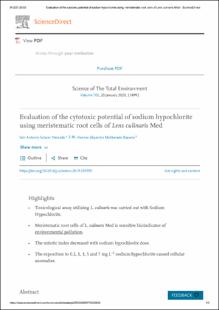| dc.contributor.author | SALAZAR MERCADO, SEIR ANTONIO | |
| dc.contributor.author | Maldonado Bayona, Hanner Alejandra | |
| dc.date.accessioned | 2021-12-09T19:17:02Z | |
| dc.date.available | 2021-12-09T19:17:02Z | |
| dc.date.issued | 2020-01-20 | |
| dc.identifier.uri | http://repositorio.ufps.edu.co/handle/ufps/1774 | |
| dc.description.abstract | The present investigation was designed to monitor the cytotoxic potential of Sodium Hypochlorite using lentil (Lens culinaris) as a bioindicator of toxicity. Sodium hypochlorite (NaClO), is a chemical compound that is used mainly for its disinfectant properties, its effect is widely toxic, which is why it is marketed in low concentrations and it is also a component in various products such as agrochemicals. In the present study the L. culinaris seeds were exposed to different NaClO dose 0, 0.2, 1, 3, 5 and 7 mg L−1 during 24, 48 and 72 h; timeslots in which the root growth was also studied. The cytotoxic potential of NaClO was determined by calculating the mitotic index (MI), calculating cellular anomalies (CA) and observing the longitudinal growth of the roots during the various time periods. The radicular growth was prolonged and it was observed that there was a greater growth at the dose of 1 and 7 mg L−1 in the time of 72 h. The cytotoxic effects could be analyzed in the mitotic index, since the higher the concentration, the lower the mitotic index, as observed in the dose of 7 mg L−1 where a reduction of the mitotic index of the meristematic cells is observed. The results indicate that NaClO has a cytotoxic effect that induces various types of chromosomal abnormalities. This indicates that Sodium Hypochlorite has a cytotoxic effect according to the increase in its dose. Therefore, Lens culinaris turned out to be a kind of appropriate bioindicator to study the cytotoxic effects of various potentially toxic substances. | eng |
| dc.format.mimetype | application/pdf | spa |
| dc.language.iso | eng | spa |
| dc.publisher | Science Of The Total Environment | spa |
| dc.relation.ispartof | Science of The Total Environment | |
| dc.rights | © 2019 Elsevier B.V. All rights reserved. | eng |
| dc.source | https://www.sciencedirect.com/science/article/abs/pii/S0048969719349848 | spa |
| dc.title | Evaluation of the cytotoxic potential of sodium hypochlorite using meristematic root cells of Lens culinaris Med | eng |
| dc.type | Artículo de revista | spa |
| dc.identifier.doi | https://doi.org/10.1016/j.scitotenv.2019.134992 | |
| dc.relation.citationedition | Vol.701 (2020) | spa |
| dc.relation.citationendpage | 3 | spa |
| dc.relation.citationstartpage | 1 | spa |
| dc.relation.citationvolume | 701 | spa |
| dc.relation.cites | Mercado, S. A. S., & Bayona, H. A. M. (2020). Evaluation of the cytotoxic potential of sodium hypochlorite using meristematic root cells of Lens culinaris Med. Science of the Total Environment, 701, 134992. | |
| dc.relation.ispartofjournal | Science of The Total Environment | spa |
| dc.rights.accessrights | info:eu-repo/semantics/restrictedAccess | spa |
| dc.subject.proposal | Cell anomalies | eng |
| dc.subject.proposal | Cell cycle | eng |
| dc.subject.proposal | Chromosome | eng |
| dc.subject.proposal | Lens culinaris | eng |
| dc.subject.proposal | Mitotic index | eng |
| dc.subject.proposal | Root lengh | eng |
| dc.type.coar | http://purl.org/coar/resource_type/c_6501 | spa |
| dc.type.content | Text | spa |
| dc.type.driver | info:eu-repo/semantics/article | spa |
| dc.type.redcol | http://purl.org/redcol/resource_type/ART | spa |
| oaire.accessrights | http://purl.org/coar/access_right/c_14cb | spa |
| oaire.version | http://purl.org/coar/version/c_970fb48d4fbd8a85 | spa |
| dc.type.version | info:eu-repo/semantics/publishedVersion | spa |










